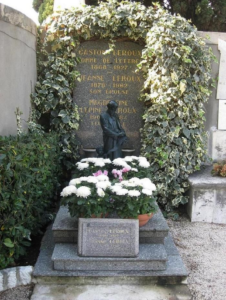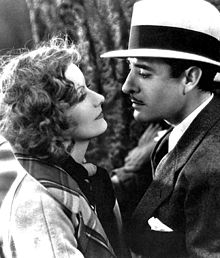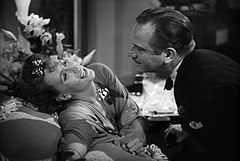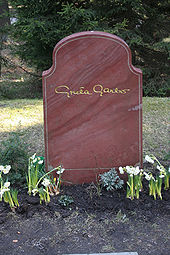 On this day in 1865, 16th President of the United States, Abraham Lincoln, died from a gunshot wound to the head, in the Petersen House which was across the street from Ford’s Theater where he had been shot by John Wilkes Booth. Lincoln died six days after General Robert E. Lee‘s surrender at Appomatox Courthouse. Born on 12 February 1809 in a one-room log cabin on the Sinking Spring Farm in southeast Hardin County, Kentucky (now LaRue County). He successfully led the country through its greatest constitutional, military and moral crisis, the American Civil War, by preserving the Union with force while ending slavery. Lincoln was the first Republican president, winning the 6 November 1860 election over Democrat Stephen Douglas and two other candidates. He won reelection in 1864 in the Union states in a landslide. Lincoln married Mary Todd (1842-1865 his death). One of the great orators in American history, his Gettysburg Address is oft quoted. Lincoln delivered the speech at the dedication of the Soldiers’ National Cemetery in Gettysburg, Pennsylvania, on the afternoon of Thursday 19 November 1863. In 272 words, and three minutes Lincoln summarized and defined the war:
On this day in 1865, 16th President of the United States, Abraham Lincoln, died from a gunshot wound to the head, in the Petersen House which was across the street from Ford’s Theater where he had been shot by John Wilkes Booth. Lincoln died six days after General Robert E. Lee‘s surrender at Appomatox Courthouse. Born on 12 February 1809 in a one-room log cabin on the Sinking Spring Farm in southeast Hardin County, Kentucky (now LaRue County). He successfully led the country through its greatest constitutional, military and moral crisis, the American Civil War, by preserving the Union with force while ending slavery. Lincoln was the first Republican president, winning the 6 November 1860 election over Democrat Stephen Douglas and two other candidates. He won reelection in 1864 in the Union states in a landslide. Lincoln married Mary Todd (1842-1865 his death). One of the great orators in American history, his Gettysburg Address is oft quoted. Lincoln delivered the speech at the dedication of the Soldiers’ National Cemetery in Gettysburg, Pennsylvania, on the afternoon of Thursday 19 November 1863. In 272 words, and three minutes Lincoln summarized and defined the war:
“Four score and seven years ago our fathers brought forth on this continent a new nation, conceived in liberty, and dedicated to the proposition that all men are created equal.
Now we are engaged in a great civil war, testing whether that nation, or any nation, so conceived and so dedicated, can long endure. We are met on a great battle-field of that war. We have come to dedicate a portion of that field, as a final resting place for those who here gave their lives that that nation might live. It is altogether fitting and proper that we should do this.
But, in a larger sense, we can not dedicate, we can not consecrate, we can not hallow this ground. The brave men, living and dead, who struggled here, have consecrated it, far above our poor power to add or detract. The world will little note, nor long remember what we say here, but it can never forget what they did here. It is for us the living, rather, to be dedicated here to the unfinished work which they who fought here have thus far so nobly advanced. It is rather for us to be here dedicated to the great task remaining before us—that from these honored dead we take increased devotion to that cause for which they gave the last full measure of devotion—that we here highly resolve that these dead shall not have died in vain—that this nation, under God, shall have a new birth of freedom—and that government of the people, by the people, for the people, shall not perish from the earth.”
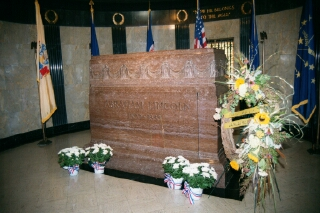 The Final Footprint – Lincoln is entombed in Lincoln’s Tomb in Oak Ridge Cemetery in Springfield, Illinois. His wife Mary and three of their four sons are entombed in the walls opposite his tomb. Lincoln’s name and image appear in numerous places, including the Lincoln Memorial in Washington, D.C., the U.S. Lincoln $5 bill and the Lincoln cent, and Lincoln’s sculpture on Mount Rushmore. Secretary of War Edwin M. Stanton, who was present when Lincoln died said, “Now he belongs to the ages.” Indeed he does.
The Final Footprint – Lincoln is entombed in Lincoln’s Tomb in Oak Ridge Cemetery in Springfield, Illinois. His wife Mary and three of their four sons are entombed in the walls opposite his tomb. Lincoln’s name and image appear in numerous places, including the Lincoln Memorial in Washington, D.C., the U.S. Lincoln $5 bill and the Lincoln cent, and Lincoln’s sculpture on Mount Rushmore. Secretary of War Edwin M. Stanton, who was present when Lincoln died said, “Now he belongs to the ages.” Indeed he does.
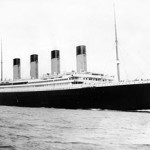 On this day in 1912, RMS Titanic sank in the north Atlantic Ocean, four days into her maiden voyage from Southampton to New York City. The largest passenger liner in service at the time, Titanic had an estimated 2,224 people on board when she struck an iceberg at 23:40 (ship’s time) on Sunday, 14 April 1912. Her sinking two hours and forty minutes later at 02:20 (05:18 GMT) on Monday, 15 April resulted in the deaths of more than 1,500 people, which made it one of the deadliest peacetime maritime disasters in history. Titanic received six warnings of sea ice on 14 April but was travelling near her maximum speed when her crew sighted the iceberg. Unable to turn quickly enough, the ship suffered a glancing blow that buckled her starboard (right) side and opened five of her sixteen compartments to the sea. Titanic had been designed to stay afloat with four of her forward compartments flooded but not more, and the crew soon realised that the ship would sink. They used rocket flares and radio (wireless) messages to attract help as the passengers were put into lifeboats. However, in accordance with existing maritime practice, the ship was carrying far too few lifeboats for everyone (though slightly more than the law required), and many boats were not filled to their capacity due to a poorly managed evacuation. The ship sank with over a thousand passengers and crew members still on board. Almost all those who jumped or fell into the water died from hypothermia within minutes. RMS Carpathia arrived on the scene about an hour and a half after the sinking and had rescued the last of the survivors in the lifeboats by 09:15 on 15 April, little more than 24 hours after Titanic‘s crew had received their first warnings of drifting ice.
On this day in 1912, RMS Titanic sank in the north Atlantic Ocean, four days into her maiden voyage from Southampton to New York City. The largest passenger liner in service at the time, Titanic had an estimated 2,224 people on board when she struck an iceberg at 23:40 (ship’s time) on Sunday, 14 April 1912. Her sinking two hours and forty minutes later at 02:20 (05:18 GMT) on Monday, 15 April resulted in the deaths of more than 1,500 people, which made it one of the deadliest peacetime maritime disasters in history. Titanic received six warnings of sea ice on 14 April but was travelling near her maximum speed when her crew sighted the iceberg. Unable to turn quickly enough, the ship suffered a glancing blow that buckled her starboard (right) side and opened five of her sixteen compartments to the sea. Titanic had been designed to stay afloat with four of her forward compartments flooded but not more, and the crew soon realised that the ship would sink. They used rocket flares and radio (wireless) messages to attract help as the passengers were put into lifeboats. However, in accordance with existing maritime practice, the ship was carrying far too few lifeboats for everyone (though slightly more than the law required), and many boats were not filled to their capacity due to a poorly managed evacuation. The ship sank with over a thousand passengers and crew members still on board. Almost all those who jumped or fell into the water died from hypothermia within minutes. RMS Carpathia arrived on the scene about an hour and a half after the sinking and had rescued the last of the survivors in the lifeboats by 09:15 on 15 April, little more than 24 hours after Titanic‘s crew had received their first warnings of drifting ice.
The Final Footprint – The disaster caused widespread public outrage over the lack of lifeboats, lax shipping regulations, and the unequal treatment of the different passenger classes aboard the ship. Inquiries set up in the wake of the disaster recommended sweeping changes to maritime regulations. This led to the establishment in 1914 of the International Convention for the Safety of Life at Sea (SOLAS). Titanic’s sinking became a cultural phenomenon, commemorated by numerous artists, film-makers, writers, composers, musicians and dancers from the time immediately after the sinking to the present day. On 1 September 1985 a joint US-French expedition led by Robert Ballard found the wreck of Titanic, and the ship’s rediscovery led to increased interest in Titanic‘s story. In 1997, James Cameron‘s eponymous film became the first movie ever to earn $1 billion at the box office, and the film’s soundtrack became the best selling soundtrack recording of all time. Numerous expeditions have been launched to film the wreck and to salvage objects from the debris field. Many artifacts have been recovered and conserved, but the wreck itself is steadily decaying. In time, Titanic‘s structure will collapse into a pile of iron and steel fragments. Eventually she will be reduced to a spot of rust on the seabed, with the remaining scraps of the ship’s hull mingled with her more durable fittings, like her propellers, the bronze capstans and the telemotor. The following memorials have been erected in memory of those who lost their lives:
Titanic Memorial, Belfast

The Titanic Memorial in Belfast was erected to commemorate the lives lost. It was funded by contributions from the public, shipyard workers and victims’ families, and was dedicated in June 1920. It is located on Donegall Square in central Belfast in the grounds of Belfast City Hall. The memorial presents an allegorical representation of the disaster in the form of a female personification of Death or Fate holding a laurel wreath over the head of a drowned sailor raised above the waves by a pair of mermaids. It has been used as the site of annual commemorations of the Titanic disaster. For a while it was obscured by the Belfast Wheel that was removed in April 2010. It is now the centrepiece of a small Titanic memorial garden that was opened on 15 April 2012, the centenary of the disaster. Together with the garden, it is the only memorial in the world to commemorate all of the victims of the Titanic, passengers and crew alike.
Memorial to the Engine Room Heroes of the Titanic
The Memorial to the Engine Room Heroes of the Titanic is a granite monument located in St. Nicholas Place, Pier Head, Liverpool, England. The city of Liverpool is strongly associated with the ill-fated liner. The RMS Titanic was owned by White Star Line which was founded in Liverpool in 1840. Liverpool was also the port of registry of the liner with the words ‘Titanic, Liverpool’ visible on the stern of the ship. The memorial on Liverpool’s waterfront is dedicated to the 244 engineers that lost their lives in the disaster as they remained in the ship supplying the stricken liner with electricity and other amenities for as long as possible. The monument is notable as the first monument in the United Kingdom to depict The Working Man. The monument dedicated to the hundreds of men who died during the sinking was designed by Sir William Goscombe John and constructed circa 1916. It stands 14.6 m tall and although it is most strongly associated with the RMS Titanic, its dedication was broadened to include all maritime engine room fatalities incurred during the performance of duty in World War I. The monument is Grade II* listed. Shrapnel damage from bombs that fell during the Second World War can be clearly seen on the monument.
Titanic Memorial (New York City)
Titanic Memorial Lighthouse
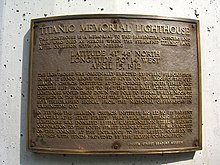
Dedication plaque on the Lighthouse
The Titanic Memorial is a 60-foot-tall (18 m) lighthouse built, due in part to the instigation of Margaret Brown, to remember the people who died on the RMS Titanic on April 15, 1912. Its design incorporates the use of a time ball.
Titanic Engineers’ Memorial, Southampton
 The Titanic Engineers’ Memorial is a memorial in East (Andrews) Park, Southampton, United Kingdom, to the engineers who died in the RMS Titanic disaster on 15 April 1912. The bronze and granite memorial was originally unveiled by Sir Archibald Denny, president of the Institute of Marine Engineers on 22 April 1914. The event was attended by an estimated 100,000 Southampton residents.
The Titanic Engineers’ Memorial is a memorial in East (Andrews) Park, Southampton, United Kingdom, to the engineers who died in the RMS Titanic disaster on 15 April 1912. The bronze and granite memorial was originally unveiled by Sir Archibald Denny, president of the Institute of Marine Engineers on 22 April 1914. The event was attended by an estimated 100,000 Southampton residents.
Titanic Memorial (Washington, D.C.)
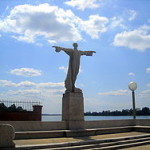 The Titanic Memorial is a granite statue in southwest Washington, D.C., that honors the men who gave their lives so that women and children might be saved during the RMS Titanic disaster. The thirteen-foot-tall figure is of a partly clad male figure with arms outstretched. The statue was erected by the Women’s Titanic Memorial Association. The memorial is located on P Street SW next to the Washington Channel near Fort Lesley J. McNair. It was designed by Gertrude Vanderbilt Whitney, who won the commission in open competition, and sculpted by John Horrigan from a single piece of red granite furnished from Westerly, RI, by the Henry C. Smalley Granite Co. It was unveiled on May 26, 1931, by Helen Herron Taft, the widow of President Taft. Originally located at the foot of New Hampshire Avenue, NW in Rock Creek Park along the Potomac River, the monument was removed in 1966 to accommodate the Kennedy Center. The memorial was re-erected without ceremony in 1968 on the south Washington waterfront outside Fort McNair in Washington Channel Park at Fourth and P Streets, SW. A replica of the head of the memorial, carved in marble and exhibited in Paris in 1921, was purchased by the French Government for the Musée du Luxembourg.
The Titanic Memorial is a granite statue in southwest Washington, D.C., that honors the men who gave their lives so that women and children might be saved during the RMS Titanic disaster. The thirteen-foot-tall figure is of a partly clad male figure with arms outstretched. The statue was erected by the Women’s Titanic Memorial Association. The memorial is located on P Street SW next to the Washington Channel near Fort Lesley J. McNair. It was designed by Gertrude Vanderbilt Whitney, who won the commission in open competition, and sculpted by John Horrigan from a single piece of red granite furnished from Westerly, RI, by the Henry C. Smalley Granite Co. It was unveiled on May 26, 1931, by Helen Herron Taft, the widow of President Taft. Originally located at the foot of New Hampshire Avenue, NW in Rock Creek Park along the Potomac River, the monument was removed in 1966 to accommodate the Kennedy Center. The memorial was re-erected without ceremony in 1968 on the south Washington waterfront outside Fort McNair in Washington Channel Park at Fourth and P Streets, SW. A replica of the head of the memorial, carved in marble and exhibited in Paris in 1921, was purchased by the French Government for the Musée du Luxembourg.
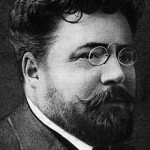 On this day in 1927, journalist and author Gaston Leroux died in Nice, France at the age of 58. In the English-speaking world, he is perhaps best known for writing the novel The Phantom of the Opera (Le Fantôme de l’Opéra, 1911). Born Gaston Louis Alfred Leroux in Paris on 6 May 1868. His novel The Mystery of the Yellow Room is also one of the most famous locked room mysteries ever written.
On this day in 1927, journalist and author Gaston Leroux died in Nice, France at the age of 58. In the English-speaking world, he is perhaps best known for writing the novel The Phantom of the Opera (Le Fantôme de l’Opéra, 1911). Born Gaston Louis Alfred Leroux in Paris on 6 May 1868. His novel The Mystery of the Yellow Room is also one of the most famous locked room mysteries ever written.
The Final Footprint – Leroux is interred in Cimetiére du Château in Nice. La Belle Otero is interred there as well. The Phantom of the Opera has been made into several film and stage productions of the same name, notably the 1925 film starring Lon Chaney, and Andrew Lloyd Webber‘s 1986 musical.
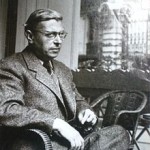 On this day in 1980, philosopher, playwright, novelist, screenwriter, political activist, biographer, and literary critic, Jean-Paul Sartre died from pulmonary edema in Paris at the age of 74. Born Jean-Paul Charles Aymard Sartre on 21 June 1905 in Paris. In my opinion, Sartre was one of the key figures in the philosophy of existentialism and phenomenology, and one of the leading figures in 20th-century French philosophy and Marxism. His work has also influenced sociology, critical theory, post-colonial theory, and literary studies, and continues to influence these disciplines. Sartre has also been noted for his open relationship with the prominent feminist theorist Simone de Beauvoir. He was awarded the 1964 Nobel Prize in Literature but refused it, saying that he always declined official honors and that “a writer should not allow himself to be turned into an institution”. In 1929 at the École Normale, he met de Beauvoir, who studied at the Sorbonne. The two became inseparable and lifelong companions, initiating a romantic relationship, though apparently, they were not monogamous. Together, Sartre and de Beauvoir challenged the cultural and social assumptions and expectations of their upbringings, which they considered bourgeois, in both lifestyle and thought. The conflict between oppressive, spiritually destructive conformity (mauvaise foi, literally, “bad faith”) and an “authentic” way of “being” became the dominant theme of Sartre’s early work, a theme embodied in his principal philosophical work L’Être et le Néant (Being and Nothingness) (1943). Sartre’s introduction to his philosophy is his work Existentialism and Humanism (1946), originally presented as a lecture.
On this day in 1980, philosopher, playwright, novelist, screenwriter, political activist, biographer, and literary critic, Jean-Paul Sartre died from pulmonary edema in Paris at the age of 74. Born Jean-Paul Charles Aymard Sartre on 21 June 1905 in Paris. In my opinion, Sartre was one of the key figures in the philosophy of existentialism and phenomenology, and one of the leading figures in 20th-century French philosophy and Marxism. His work has also influenced sociology, critical theory, post-colonial theory, and literary studies, and continues to influence these disciplines. Sartre has also been noted for his open relationship with the prominent feminist theorist Simone de Beauvoir. He was awarded the 1964 Nobel Prize in Literature but refused it, saying that he always declined official honors and that “a writer should not allow himself to be turned into an institution”. In 1929 at the École Normale, he met de Beauvoir, who studied at the Sorbonne. The two became inseparable and lifelong companions, initiating a romantic relationship, though apparently, they were not monogamous. Together, Sartre and de Beauvoir challenged the cultural and social assumptions and expectations of their upbringings, which they considered bourgeois, in both lifestyle and thought. The conflict between oppressive, spiritually destructive conformity (mauvaise foi, literally, “bad faith”) and an “authentic” way of “being” became the dominant theme of Sartre’s early work, a theme embodied in his principal philosophical work L’Être et le Néant (Being and Nothingness) (1943). Sartre’s introduction to his philosophy is his work Existentialism and Humanism (1946), originally presented as a lecture.
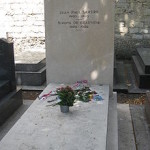 The Final Footprint – Sartre is entombed in Cimetière de Montparnasse in Paris. Evidently, his funeral was well attended, with estimates of the number of mourners along the two hour march ranging from 15,000 to over 50,000.
The Final Footprint – Sartre is entombed in Cimetière de Montparnasse in Paris. Evidently, his funeral was well attended, with estimates of the number of mourners along the two hour march ranging from 15,000 to over 50,000.
In 1975, when asked how he would like to be remembered, Sartre replied:
“I would like [people] to remember [my novel] Nausea, [my plays] No Exit and The Devil and the Good Lord, and then my two philosophical works, more particularly the second one, Critique of Dialectical Reason. Then my essay on Genet, Saint Genet…. If these are remembered, that would be quite an achievement, and I don’t ask for more. As a man, if a certain Jean-Paul Sartre is remembered, I would like people to remember the milieu or historical situation in which I lived,… how I lived in it, in terms of all the aspirations which I tried to gather up within myself.”
De Beauvoir was entombed next to him upon her death in 1986. Other notable Final Footprints at Montparnasse include; Charles Baudelaire, Samuel Beckett, Emmanuel Chabrier, Guy de Maupassant, Adah Isaac Menken, Camille Saint-Saëns, Jean Seberg, and Susan Sontag.
| Greta Garbo | |
|---|---|
On this day in 1990, film actress Greta Garbo died in New York City at the age of 84 from pneumonia and renal failure. Born Greta Lovisa Gustafsson on 18 September 1905 in Stockholm. Garbo was nominated three times for the Academy Award for Best Actress and received an Academy Honorary Award in 1954 for her “luminous and unforgettable screen performances.”
Garbo launched her career with a secondary role in the 1924 Swedish film The Saga of Gosta Berling. Her performance caught the attention of Louis B. Mayer, chief executive of Metro-Goldwyn-Mayer (MGM), who brought her to Hollywood in 1925. She immediately stirred interest with her first silent film, Torrent, released in 1926; a year later, her performance in Flesh and the Devil, her third movie, made her an international star.
Garbo’s first talking film was Anna Christie (1930). MGM marketers enticed the public with the catch-phrase “Garbo talks!” That same year she starred in Romance. For her performances in these films she received the first of three Academy Award nominations for Best Actress. (Academy rules at the time allowed for a performer to receive a single nomination for their work in more than one film). In 1932, her popularity allowed her to dictate the terms of her contract and she became increasingly selective about her roles. Her success continued in films such as Mata Hari (1931) and Grand Hotel (1932). Many critics and film historians consider her performance as the doomed courtesan Marguerite Gautier in Camille (1936) to be her finest. It is certainly my personal favorite. The role gained her a second Academy Award nomination. For her role in Ninotchka (1939), she earned her third Academy Award nomination. She retired from the screen, at the age of 35, after acting in twenty-eight films.
From then on, Garbo declined all opportunities to return to the screen. Shunning publicity, she began a private life. Garbo also became an art collector in her later life; her collection, included works from painters such as Pierre-Auguste Renoir, Pierre Bonnard, and Kees van Dongen.
From the early days of her career, Garbo avoided industry social functions, preferring to spend her time alone or with friends. She never signed autographs or answered fan mail, and rarely gave interviews. Nor did she ever appear at Oscar ceremonies, even when she was nominated. Her aversion to publicity and the press was genuine, and exasperating to the studio at first. In an interview in 1928, she explained that her desire for privacy began when she was a child, stating “as early as I can remember, I have wanted to be alone. I detest crowds, don’t like many people.”
She is closely associated with a line from Grand Hotel, “I want to be alone; I just want to be alone.”
On 9 February 1951, she became a naturalized citizen of the United States and, in 1953, bought a seven-room apartment at 450 East 52nd Street in Manhattan, New York City, where she lived for the rest of her life.
Garbo never married, had no children. Her most famous romance was with her frequent co-star, John Gilbert, with whom she lived intermittently in 1926 and 1927. Gilbert allegedly proposed to her numerous times, with Garbo agreeing but backing out at the last minute. “I was in love with him,” she said. “But I froze. I was afraid he would tell me what to do and boss me. I always wanted to be the boss.”
In 1937, she met conductor Leopold Stokowski, with whom she had a highly publicized friendship or romance while traveling throughout Europe the following year. In his diary, Erich Maria Remarque discusses a liaison with Garbo in 1941. In his memoir, Cecil Beaton described an affair with her in 1947 and 1948. In 1941 she met the Russian-born millionaire, George Schlee, who was introduced to her by his wife, fashion designer Valentina. Nicholas Turner, Garbo’s close friend for 33 years, said that, after she bought an apartment in the same building, “Garbo moved in and took Schlee right away from Valentina.” Schlee would split his time between the two, becoming Garbo’s close companion and advisor until his death in 1964.
In 1927, Garbo was introduced to stage and screen actress Lilyan Tashman and they may have had an affair. Silent film star Louise Brooks stated that she and Garbo had a brief liaison.
In 1931, Garbo befriended the writer Mercedes de Acosta, introduced to her by her close friend, Salka Viertel, and, according to Garbo’s and de Acosta’s biographers, began a sporadic and volatile romance. The two remained friends for almost 30 years, during which time Garbo wrote de Acosta 181 letters, cards, and telegrams, now at the Rosenbach Museum & Library in Philadelphia.
Of Mimi Pollak, Garbo wrote “We cannot help our nature, as God has created it. But I have always thought you and I belonged together”. In 1975, she wrote a poem about not being able to touch the hand of her friend with whom she might have been walking through life.
The Final Footprint
Garbo was cremated in Manhattan, and her ashes were interred in 1999 at Skogskyrkogården Cemetery just south of her native Stockholm.
 On this day in 2001, musician, singer-songwriter, and lead vocalist of the punk rock band the Ramones, Joey Ramone died at the age of 49 following a seven-year battle with lymphoma at New York-Presbyterian Hospital. Born Jeffrey Ross Hyman on May 19, 1951 in Queens. His image, voice, and tenure as frontman of the Ramones made him a countercultural icon.
On this day in 2001, musician, singer-songwriter, and lead vocalist of the punk rock band the Ramones, Joey Ramone died at the age of 49 following a seven-year battle with lymphoma at New York-Presbyterian Hospital. Born Jeffrey Ross Hyman on May 19, 1951 in Queens. His image, voice, and tenure as frontman of the Ramones made him a countercultural icon.
In 1974, Hyman co-founded the punk rock band the Ramones with friends John Cummings and Douglas Colvin. Colvin was already using the pseudonym “Dee Dee Ramone” and the others also adopted stage names using “Ramone” as their surname: Cummings became Johnny Ramone and Hyman became Joey Ramone. Joey initially served as the group’s drummer while Dee Dee was the original vocalist. However, when Dee Dee’s vocal cords proved unable to sustain the demands of consistent live performances, Ramones manager Thomas Erdelyi suggested Joey switch to vocals. After a series of unsuccessful auditions in search of a new drummer, Erdelyi took over on drums, assuming the name Tommy Ramone.
The Ramones were a major influence on the punk rock movement in the United States. Recognition of the band’s importance built over the years, and they are now regularly represented in many assessments of all-time great rock music–. In 1996, after a tour with the Lollapalooza music festival, the band played their final show and then disbanded.
The Final Footprint

He was reportedly listening to the song “In a Little While” by U2 when he died. His solo album Don’t Worry About Me was released posthumously in 2002, and features the single “What a Wonderful World”, a cover of the Louis Armstrong standard. MTV News claimed: “With his trademark rose-colored shades, black leather jacket, shoulder-length hair, ripped jeans and alternately snarling and crooning vocals, Joey was the iconic godfather of punk.”
On November 30, 2003, a block of East 2nd Street in New York City was officially renamed Joey Ramone Place. It is the block where Hyman once lived with bandmate Dee Dee and is near the former site of the music club CBGB, where the Ramones began their career. Hyman’s birthday is celebrated annually by rock ‘n’ roll nightclubs, hosted in New York City by his brother and, until 2007, his mother, Charlotte. He is interred at Hillside Cemetery in Lyndhurst, New Jersey. Another notable final footprint at Hillside is that of William Carlos Williams.
The Ramones were named as inductees to the Rock and Roll Hall of Fame as part of the class of 2002.
Several songs have been written in tribute to Joey Ramone. Tommy, CJ and Marky Ramone and Daniel Rey came together in 2002 to record Jed Davis’ Joey Ramone tribute album, The Bowery Electric. Other tributes include “Hello Joe” by Blondie from the album The Curse of Blondie, “Don’t Take Me For Granted” by Social Distortion, “You Can’t Kill Joey Ramone” by Sloppy Seconds, Joey by Raimundos, “I Wanna Be Your Joey Ramone” by Sleater-Kinney, “Red and White Stripes” by Moler and “Joey” by the Corin Tucker Band, “I Heard Ramona Sing” by Frank Black, and Amy Rigby’s “Dancin’ With Joey Ramone”. Rammstein ended several shows of their Mutter tour in 2001 with a cover of “Pet Sematary” in honor of the passing of Joey Ramone. “The Miracle (of Joey Ramone)” by U2.
In September 2010, the Associated Press reported that “Joey Ramone Place,” a sign at the corner of Bowery and East Second Street, was New York City’s most stolen sign. Later, the sign was moved to 20 ft (6.1 m) above ground level. Drummer Marky Ramone thought Joey would appreciate that his sign would be the most stolen, adding “Now you have to be an NBA player to see it.”
After several years in development, Ramone’s second posthumous album was released on May 22, 2012. Titled …Ya Know?, it was preceded on Record Store Day by a 7″ single re-release of “Blitzkrieg Bop”/”Havana Affair”.
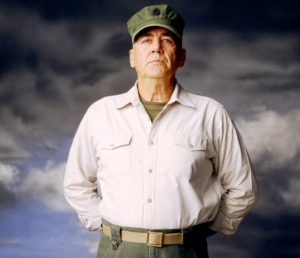 And on this day in 2018, actor, drill instructor, staff sergeant, honorary gunnery sergeant, Marine R. Lee Ermey died in Santa Monica, California, from complications related to pneumonia, at the age of 73. Born Ronald Lee Ermey on March 24, 1944 in Emporia, Kansas. Perhaps best known for his role as Gunnery Sergeant Hartman in the 1987 film Full Metal Jacket, which earned him a Golden Globe Award nomination for Best Supporting Actor.
And on this day in 2018, actor, drill instructor, staff sergeant, honorary gunnery sergeant, Marine R. Lee Ermey died in Santa Monica, California, from complications related to pneumonia, at the age of 73. Born Ronald Lee Ermey on March 24, 1944 in Emporia, Kansas. Perhaps best known for his role as Gunnery Sergeant Hartman in the 1987 film Full Metal Jacket, which earned him a Golden Globe Award nomination for Best Supporting Actor.
Ermey was often typecast in authority figure roles, such as Mayor Tilman in the film Mississippi Burning, Bill Bowerman in Prefontaine, Sheriff Hoyt in The Texas Chainsaw Massacre remake, Jimmy Lee Farnsworth in Fletch Lives, a police captain in Se7en, plastic army men leader Sarge in the Toy Story films, Lt. “Tice” Ryan in Rocket Power, a prison warden in an episode of SpongeBob SquarePants, and John House in House.
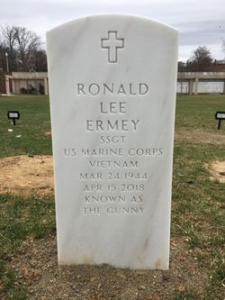 The Final Footprint
The Final Footprint
His funeral was held in Arlington National Cemetery on Friday, January 18, 2019, where his cremated remains are interred. Other notable Final Footprints at Arlington include; Space Shuttle Challenger, Space Shuttle Columbia, Medgar Evers, JFK, Jacqueline Bouvier Kennedy Onassis, RFK, Edward Kennedy, Malcolm Kilduff, Jr., Lee Marvin, and Audie Murphy.
Have you planned yours yet?
Follow TFF on twitter @RIPTFF


